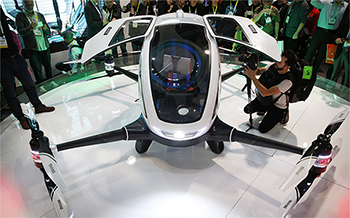Aerospace Entrepreneurs Try and Find a Way Around City Traffic Written 8 June 2017
Panelists: Moderators Brian J. German, associate professor, Daniel Guggenheim School of Aerospace Engineering, Georgia Institute of Technology; JoeBen Bevirt, founder, Joby Aviation; Geoffrey Bower, chief engineer, A^3 by Airbus Group; Gregory J. Bowles, vice president of global innovation and policy, General Aviation Manufacturers Association; David Josephson, engineer/CEO, Josephson Engineering Inc.; Mark D. Moore, director of aviation, Uber Engineering; Tine Tomažič, director of research and development, Pipistrel; Jon Rimanelli, founder and CEO, AirspaceX
by Hannah Godofsky, AIAA Communications

A new wave of aerospace entrepreneurs and technology startups are stepping in to try and solve the problem of traffic, and according to a panel of experts at the 2017 AIAA AVIATION Forum in Denver, it could be done with vertical takeoff and landing, or VTOL, aircraft.
As any commuter knows, roadway congestion eats up a huge amount of time and energy, and “traffic is taking over our lives,” Jon Rimanelli, founder and CEO of AirspaceX, said during the discussion June 8.
Rimanelli cited figures showing that each driver loses about $1,400 in fuel costs and productivity each year due to traffic.
“Key to this future is leveraging the automotive industrial base,” he said, adding that his company works with Uber, which has disrupted the taxi and car markets with its ridesharing app.
“Our mission is to support Uber, and their mission is to move people,” Rimanelli said.
Mark Moore, director of aviation at Uber Engineering, said his company’s working on making electric VTOL a reality and plans to tests the system as soon as 2020.
“Uber is going to connect the users to the network. Uber is a software company, and there is a great deal of software in this ecosystem,” Moore said. “Uber will be very active in developing the network, including the network operations center.”
But, Moore insists, “We see many participants in this system.”
One such example is Pipistrel, whose director of research and development, Tine Tomažič, explained where electric flight is at in terms of development today.
“We understand what happens when you are really challenged with power demands,” Tomažič said.
However, he said, some of the problems that still need to be solved before e-VTOL is a reality on a mass scale aren’t directly related to the vehicles themselves.
“When these vehicles are connected all the time to the service network, one has to think, ‘how do you isolate the vehicles from cyberattacks?’” Tomažič said.
Other obstacles panelists noted are potential objections from local governments or federal regulators.
“You have to make the case that the tradeoff between noise to the community and benefit to the community is positive,” said David Josephson, engineer and CEO of Josephson Engineering Inc.
Greg Bowles, vice president of global innovation and policy at the General Aviation Manufacturers Association, said he’s skeptical the infrastructure is ready for e-VTOL on a mass scale.
“When we talk about the needs of charging one of these vehicles in five minutes, it’s like adding a grocery store to the grid for five minutes,” Bowles said.
Despite these risks, even large companies like Airbus are investing in e-VTOL technology, said Geoffrey Bower, chief engineer of A^3 at Airbus Group.
“We’re trying to disrupt Airbus and the rest of the aerospace industry before somebody else does,” he said. “The technology, the components are there; we just need the integration.”
Rimanelli urged regulators: “What we need you to do is collaborate, partner or get out of the way.”
